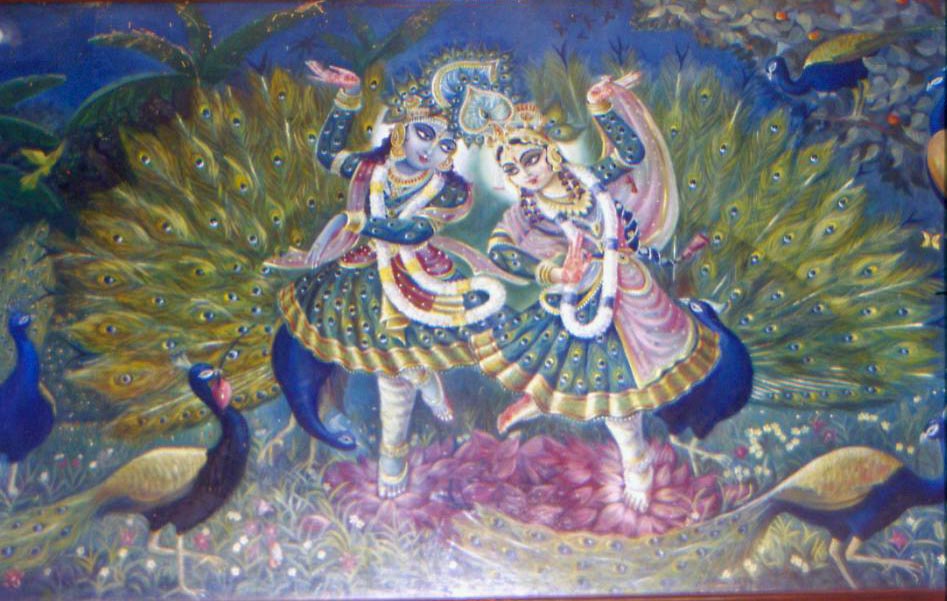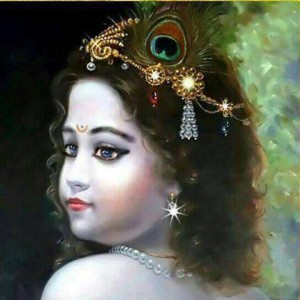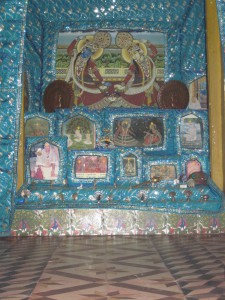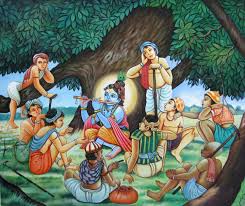Krishna’s Dance with the Peacocks
1. The Awakening Melody One day, Krishna awoke first from a rest in the forest with His cowherd friends. Desiring to wake everyone and call the cows grazing at a distance, He played His flute. The nectar from His lips produced a melodious raga with a slow rhythm and a deep base. This wonderful vibration enchanted the peacocks around Govardhan Hill.
Lesson: Krishna’s flute represents the divine call of the Lord that awakens and attracts all living beings towards Him.
2. The Dance of the Peacocks The hearts of the peacocks began to sing with happiness, filling the skies with their song. Encouraged by Krishna’s kind glances and sweet smile, they started dancing. The joy of their dance resonated through the hills, creating a jubilant atmosphere.
Lesson: The Lord’s presence and encouragement inspire boundless joy and creativity in His devotees.
3. The Peacock King’s Request The king of the peacocks approached Krishna, touched His lotus feet, and made a sound that Krishna understood as a request to join their dance. Krishna graciously accepted and began dancing amidst the peacocks, matching the rhythm and tempo of their dance. This elevated the bliss of the peacocks to such an extent that some fainted from the overwhelming joy.
Lesson: The Lord is ever-willing to engage with His devotees, elevating their joy and devotion to divine heights.
4. The Audience’s Captivation All the animals and cowherds of Govardhan Hill stood transfixed, unable to take their eyes off Krishna’s dance. The flute in Krishna’s hand, moved by its master’s uncommon performance, began to sing on its own, adding to the enchanting spectacle.
Lesson: Witnessing the Lord’s pastimes is a transformative experience that captivates and purifies the heart.
5. The Offering of Feathers When the dance ended, the king of the peacocks humbly approached Krishna. Bowing down, he expressed gratitude and requested Krishna to accept their only opulence, their plumage, as an offering. Krishna, with large tears of ecstasy, accepted the feathers and placed a few on His turban, to the joy of all present.
Lesson: Offering our best to the Lord, no matter how humble, is an expression of our devotion and gratitude. The Lord graciously accepts and cherishes these offerings.
Conclusion This beautiful pastime emphasizes the importance of offering our best to Krishna and being grateful for His blessings. It also highlights how Krishna values even the simplest offerings of love and devotion, exemplified by His acceptance of the peacock feathers as a cherished adornment.
Moral of the Story: Offer the best of what you have to Krishna with a loving and grateful heart. Appreciate and be thankful for all acts of kindness, no matter how small, as they signify love and have great value. Krishna’s acceptance of the peacock feathers shows His gratitude for their service, teaching us to cherish every act of devotion.
Hare Krishna Mahamantra: Hare Krishna, Hare Krishna, Krishna Krishna, Hare Hare
Hare Rama, Hare Rama, Rama Rama, Hare Hare
PS: I humbly request all devotees to please forward and share these moral/instructive stories so that everyone can benefit from hearing about Krishna and His dear devotees.



